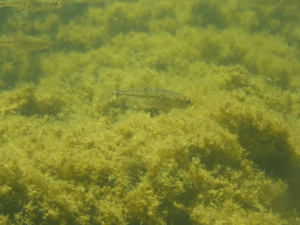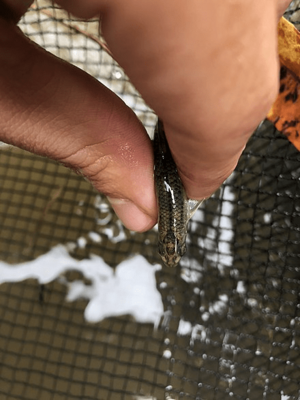Umpqua chub facts for kids
Quick facts for kids Umpqua chub |
|
|---|---|
 |
|
| Three Umpqua chub in the South Umpqua River (Photo taken during snorkel survey). | |
| Conservation status | |
| Scientific classification |
The Umpqua chub (Oregonichthys kalawatseti) is a small freshwater fish. It belongs to the Cyprinidae family, which includes carps and minnows. This special fish lives only in the Umpqua River and its connected streams in Oregon, United States. This means it is an endemic species to that area. You can find it in the main Umpqua River and its smaller branches like the North Umpqua, South Umpqua, Smith River, Calapooya, Cow Creek, and Ollala Creek. Scientists have found that even though they live in different places, there are four main groups of Umpqua chub that are genetically unique.
Contents
Where the Umpqua Chub Lives
Umpqua chub usually prefer to live in water that moves slowly. If they are found in faster moving rivers, they often stay close to the banks. They like to hide in small pools and side-channels. These spots are often under plants that grow along the riverbanks.
What the Umpqua Chub Eats
Scientists don't know a lot about what Umpqua chub eat every day. However, some studies have given us clues. For example, researchers looked inside 20 Umpqua chub from the Calapooya River. They found small traces of different insects and even sand. These included tiny midge larvae, diving beetles, and mayflies.
Why Umpqua Chub Numbers Are Shrinking
Sadly, the number of Umpqua chub is going down. One big reason for this decline is the introduction of another fish called the Smallmouth bass. Smallmouth bass are not native to the Umpqua River. They are thought to be causing problems for the Umpqua chub in a few ways. They might be eating the Umpqua chub directly. They could also be competing with the chub for food and living space.
How to Identify an Umpqua Chub
Umpqua chub are generally small fish. They are usually less than 65 millimeters (about 2.5 inches) long. This measurement is taken from their nose to the fork in their tail.
They have a dark brown line running along their side, called a lateral line. Above this line, their scales have a peppered brown look. This pattern goes from their tail all the way to their nose.
One very special mark that helps identify an Umpqua chub is on its head. It has a unique upside-down heart shape right behind its eyes. The Umpqua chub also has a mouth that opens at the very front of its head. Its tail fin is slightly forked, not deeply split.




